If you’re new to fitness, creating the perfect workout routine can feel like a daunting task. The good news? You don’t need to spend hours in the gym or follow complex regimens to see results. If your goal is to lose weight, build muscle, or just feel more energized, a customized routine tailored to women and beginners is the best place to start.
This guide will help you understand how to create a workout plan that fits your goals, schedule, and fitness level. You’ll learn about different workout training splits, how to structure your week, and what exercises to include in a solid beginner workout plan for women. Ready to get started? Let’s build a sustainable and effective workout routine that works for you.
Why Women Need Specific Workout Plans
Women’s bodies differ from men’s in several ways, including hormones, metabolism, and muscle composition. These differences can affect how women respond to certain types of exercise. Research has shown that women recover faster between sets and may benefit from different strength training strategies compared to men.
A dedicated workout plan for women takes these factors into account. It balances cardio, strength training, flexibility, and recovery while also considering common fitness goals such as fat loss, lean muscle gain, or improved endurance.
Discover: Abs Workouts and Core Exercises for Men and Women
Step 1: Define Your Fitness Goal
Before diving into exercises and schedules, ask yourself a key question: What do you want to achieve with your workout routine?
- Do you want to lose weight?
- Build lean muscle?
- Boost energy and improve overall health?
Knowing your goal helps determine the structure of your workouts and plans. For example, a weight loss exercise plan will include more cardio and higher workout frequency, while a muscle gain plan will focus on strength and progressive overload.

Step 2: Choose the Right Split Workout Routine
Once your goal is clear, it’s time to choose a split workout routine. This refers to how you divide your workouts throughout the week.
Full Body Workout Routines (3 Days a Week)
Ideal for beginners. You target all major muscle groups in one session.
Example Schedule:
- Monday: Full body
- Wednesday: Full body
- Friday: Full body
Pros:
- Efficient and time-saving
- Builds a solid foundation
- Easier to stick with

Upper-Lower Split (4 Days a Week)
You alternate between upper and lower body sessions.
Example Schedule:
- Monday: Upper body
- Tuesday: Lower body
- Thursday: Upper body
- Friday: Lower body
Pros:
- More focused work per muscle group
- Balanced approach for strength and endurance
Push-Pull-Legs Split (5-6 Days a Week)
An advanced method that splits workouts into movement types:
- Push (chest, shoulders, triceps)
- Pull (back, biceps)
- Legs (quads, hamstrings, glutes)
This type of workout training splits is best used after mastering the basics.
Explore: Top Bicep Workouts for Massive Arms in 2025
Step 3: Build Your Weekly Workout Schedule
Creating a realistic and manageable workout schedule for women is key. Here’s a sample beginner week using a full body workout routine.
| Day | Workout Focus |
| Monday | Full body + light cardio |
| Tuesday | Rest or gentle yoga |
| Wednesday | Full body + core focus |
| Thursday | Light cardio (walking or cycling) |
| Friday | Full body + flexibility training |
| Saturday | Active recovery or an optional class |
| Sunday | Full rest |
This structure balances movement and rest. It also keeps the plan adaptable and sustainable.
Step 4: Exercise Selection for Beginners
Your beginner workouts plan for women should include foundational movements that target multiple muscle groups.
Lower Body Exercises
- Bodyweight squats
- Glute bridges
- Step-ups
- Reverse lunges
Upper Body Exercises
- Wall pushups or incline pushups
- Dumbbell shoulder presses
- Bent-over rows
- Dumbbell curls
Core Work
- Plank (start with 20-30 seconds)
- Bird-dog
- Russian twists
- Leg lifts

Perform 2-3 sets of 10-15 reps for each move. Focus on form and control.
Step 5: Add Cardio and Flexibility
Cardio is essential in any weight loss exercise plan. It improves heart health, burns calories, and boosts endurance.
Cardio Options:
- Brisk walking (30-45 minutes)
- Jogging
- Jump rope
- Dance or aerobic class
- HIIT (High Intensity Interval Training)
Aim for 2-3 cardio sessions weekly. Mix them into your workout schedule for women based on your energy levels.
Flexibility and mobility work are equally important. Spend 5-10 minutes stretching after workouts to improve recovery and reduce injury risk.
Step 6: Understand Progressive Overload
Once you’re comfortable with your routine, it’s time to progress. Progressive overload means gradually increasing your workout challenge. This can be done by:
- Adding reps or sets
- Increasing weight
- Reducing rest between sets
This ensures your body continues adapting and improving over time.

Step 7: Nutrition and Hydration Support
Your workout routine is only half the equation. Fueling your body correctly supports your progress. Focus on:
- Lean proteins (chicken, tofu, eggs)
- Complex carbs (oats, brown rice, vegetables)
- Healthy fats (avocado, olive oil, nuts)
- Plenty of water (at least 8 glasses a day)
Hydration supports energy, recovery, and performance.
Step 8: Rest and Recovery
Don’t underestimate rest. Muscles grow and repair during downtime. Rest days prevent burnout and reduce injury risk.
Use recovery tools like foam rollers, stretching routines, and quality sleep to aid your body’s healing process.
Step 9: Tracking Progress
Tracking helps you stay motivated and focused. You can track:
- Reps, sets, and weight used
- How do you feel after workouts
- Body measurements or photos (optional)
- Milestones (e.g., first pushup, 5K run, etc.)
Keeping a log (app or journal) provides clarity and encourages consistency.

Step 10: Stick With It and Stay Flexible
Every fitness journey has ups and downs. The key is showing up, even when motivation dips. Some tips to help you stick to your workout plans for women:
- Schedule your workouts like appointments
- Keep your gear ready the night before
- Try new classes or formats to keep it fun
- Find a workout buddy or community
- Celebrate small victories
Consistency over time brings results. Trust the process.
Example 3-Day Beginner Full Body Workout Routine
Day 1: Strength Focus
- Warm-up: 5 mins brisk walking
- Squats: 2 sets x 12 reps
- Dumbbell rows: 2 sets x 10 reps
- Glute bridges: 2 sets x 15 reps
- Plank: 2 x 30 seconds
- Stretch: 5 mins
Day 2: Cardio + Core
- Warm-up: Jumping jacks x 2 mins
- 20 minutes of brisk walking or a dance workout
- Leg raises: 2 x 12
- Bird-dog: 2 x 10 (each side)
- Cool down: Gentle stretching
Day 3: Full Body Mix
- Warm-up: Arm swings, leg swings, bodyweight squats
- Step-ups: 2 sets x 12
- Pushups (wall or knee): 2 x 10
- Dumbbell shoulder press: 2 x 10
- Russian twists: 2 x 20 (10 per side)
- Cool down: 5 mins of yoga
Can I target fat loss in specific areas?
Spot reduction, or losing fat in a specific area, is a common misconception. Fat loss occurs throughout the body based on genetics and overall activity levels. Combining a balanced diet with regular cardio and strength training promotes overall fat loss, leading to reductions in targeted areas over time.
Therefore, Create a Workout Routine That Works for You
Learning how to create a workout plan doesn’t require a personal trainer or fancy equipment. Start small, stay consistent, and build up as you gain strength and confidence.
Choose a split workout routine that fits your schedule and lifestyle. You can prefer full body workout routines, workout training splits, or a more flexible mix of workouts and plans, the key is to start where you are.
By tailoring your workout plan for women and beginners, you’ll not only see results faster but also create habits that last a lifetime. Remember: fitness is not a destination; it’s a journey.

